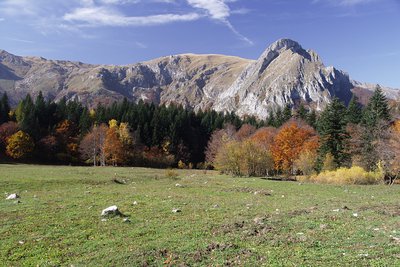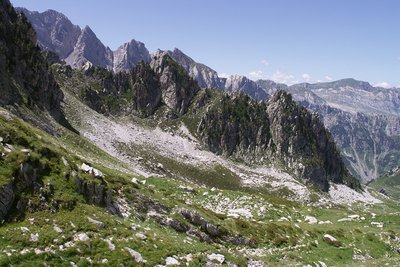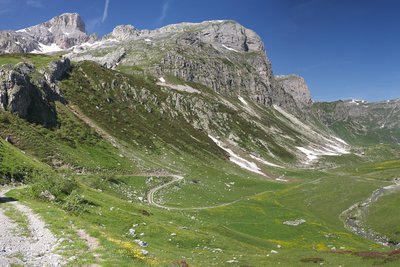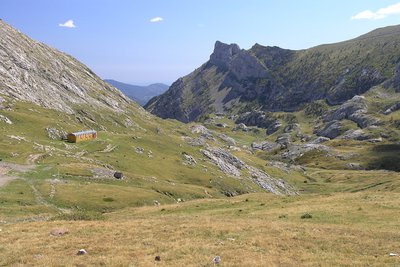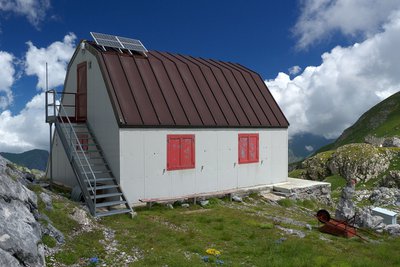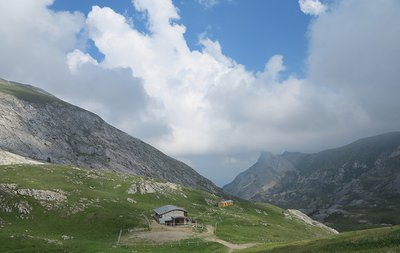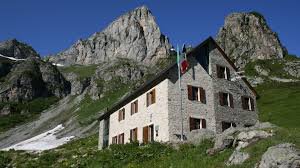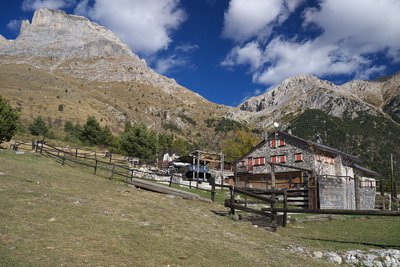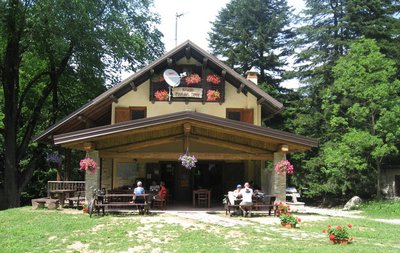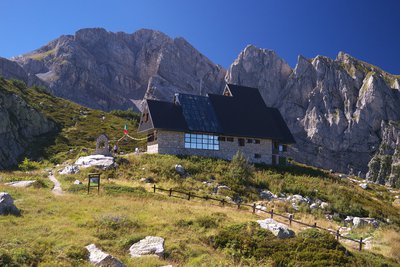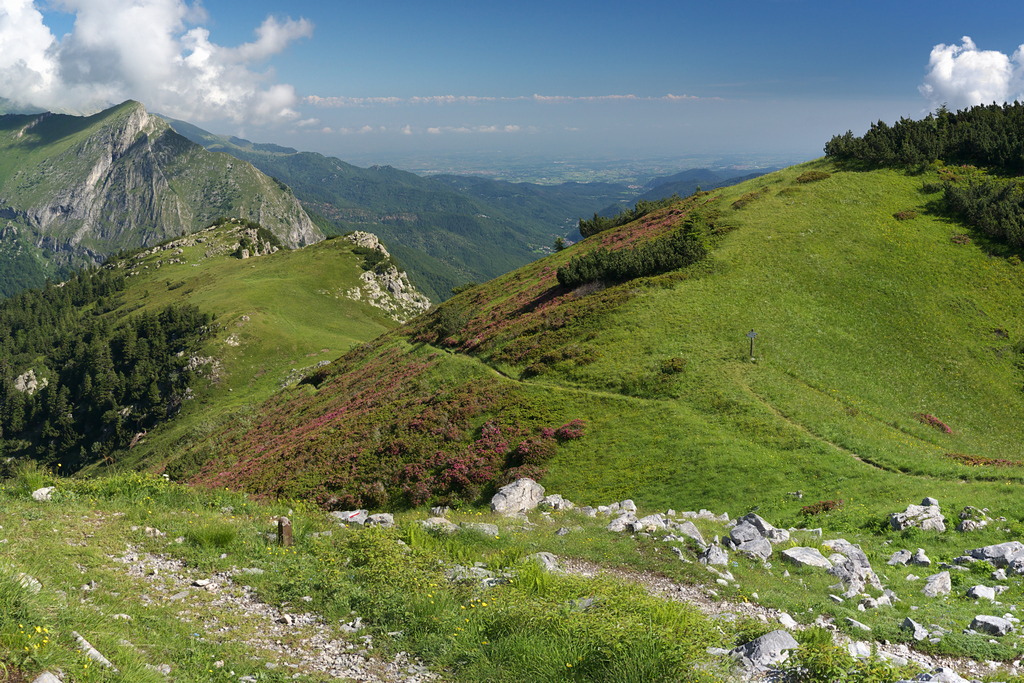
Giro del Marguareis
You could define this circuit as being in the kingdom of karst, where the pasture as far as the eye can see, interspersed with vertical limestone walls are the principal features. And then dolines, limestone pavements and expanses of white rocks. The lakes are missing, as karst terrain absorbs water at high altitude; but there is no shortage of waterfalls, especially in mid-valley areas, where underground water courses come to light with spectacular results.
5 steps
4 points of interest
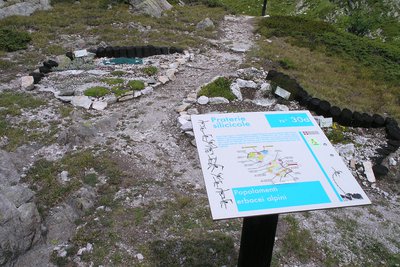
La stazione botanica Burnat Bicknell - Roberto Pockaj  Flora
FloraThe Burnat Bicknell Botanical Station
The site covers over 10,000 square meters, and is named after Emile Burnat and Clarence Bicknell. Burnat, a Swiss botanist, was the author of the important work 'Flores des Alpes Maritimes'; Bicknell, an English botanist active in Valle Pesio for about thirty years, he was also the first to catalogue the rock engravings of Monte Bego.
About 500 plant species typical of the Ligurian Alps are collected in the two botanical stations, offering a unique opportunity for both enthusiasts and casual visitors. Illustrative panels describe the various environments and the botanical species are easily recognizable thanks to the scientific name on the labels.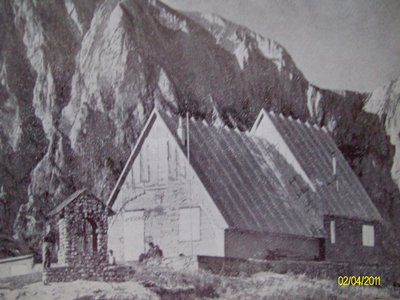
Il vecchio Rifugio Garelli - CAI Mondovì  History and historical trail
History and historical trailPier Mario Garelli
The refuge was dedicated to Pier Mario Garelli when it was built. He was known to all as Piero, a lawyer and climbing partner of Sandro Comino. President of the CAI of Mondovì, immediately after the armistice he joined the Resistance, with the III Alpine Division operating in Val Casotto. He was arrested in Mondovì, and initially locked up in Turin. On May 25, 1944 he was transferred to the concentration camp at Fossoli, then to Bolzano and finally to the concentration camp at Mauthausen. He died in the subcamp of Gusen, just before the end of hostilities.

Fenomeni erosivi su rocce calcaree - Roberto Pockaj  Geology
GeologyThe furrowed fields
The 'furrowed fields' (also called 'carried fields' due to the shapes that vaguely recall the furrows left by the wheels of carts in the mud) are erosion phenomena typical of limestone rocks, due to the runoff of rainwater.
La Conca delle Carsene - Archivio EAM  Geology
GeologyLa Conca delle Cársene
The Conca delle Càrsene is a vast plateau consisting of limestone rocks, characterized by expanses of bare, white rocks alternating with grassy cover.
It manifests the typical aspects of karst areas with limestone pavement, dolines and sinkholes. A superficial hydrographic network is completely missing: rain and snow meltwater are immediately absorbed and give rise to the resurgence of Pis del Pesio, located several hundred metres below.
Curiously, there are also areas located beyond the Alpine watershed, such as Plan Ambreuge, that are part of the catchment area, so water falling south of the Alps, after an underground journey, flow out on the Italian side.[Alpi Liguri, p.80]
[La Guida del Parco Alta Valle Pesio e Tanaro, pp.46-47]
Description
The official route of the Marguareis tour includes five stages. But one of the merits of this ring is the number of paths that connect the stopping places: you can organise the route at will, reducing it to a quick tour around Marguareis in a couple of days, or extending it to five days taking in Mongioie .
Even departure is at your choice: usually Pian delle Gorre, in Valle Pesio, but it is equally good to start from Carnino in the upper Tanaro Valley.
All stopping places are in managed refuges that provideaccomodation and, on request, packed lunches.
The ideal period for hiking is July to September. In the years with little snow even June and sometimes the beginning of October (you should check accommodation opening). August is not a problem, if you take into account the probability of a little heat and clouds that tend to form from lunchtime on.
- Departure : Rifugio Pian delle Gorre (1032 m)
- Arrival : Rifugio Pian delle Gorre (1032 m)
- Towns crossed : Chiusa di Pesio, Briga Alta, Ormea, and La Brigue
Altimetric profile
Transport
https://www.savgroup.it/linee/43.pdf
SNCF line TER Provence Alpes-Côte d'Azur For travel in the PACA region and towards Cuneo www.ter-sncf.com/pac
Trenitalia for travel in the Piedmont region https://www.trenitalia.com/it.html
Access and parking
Parking :
Report a problem or an error
If you have found an error on this page or if you have noticed any problems during your hike, please report them to us here:
Close by5
- Mountain Hut
Mountain Hut
Rifugio Don Barbera
The current structure, in stone and wood, is the result of a complete renovation recently carried out. It is a comfortable refuge, suitable for hikers as well as for groups and schools.
The refuge is located a few meters from the Colle dei Signori, immersed in the austere and uncontaminated nature of the upper Pesio and Tanaro valley natural park. - Mountain Hut
Mountain Hut
Rifugio Havis De Giorgio - Mondovì
The Mondovì Refuge is an oasis of peace at over 1700 meters above sea level, a magical place where spectacular nature envelops you in wonders.
Come and visit us, Mariolino's cuisine awaits you, with its legendary blueberry tarts, fondues, mountain pasture raschera... as many as 61 beds can also accommodate large companies! - Mountain Hut
Mountain Hut
Rifugio Mongioie
Located on the large plateau (Pian Rosso) above the town of Viozene, the Mongioie refuge is the ideal starting point for excursions at high altitude.
The Mongioie massif (2630m) slopes down towards the refuge with spectacular limestone formations up to 350m high where you can climb beautiful rock.
In addition, there are many activities related to the mountain accompanied by typical and seasonal cuisine.

